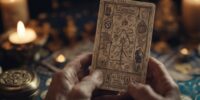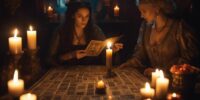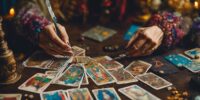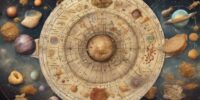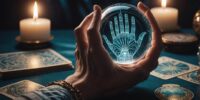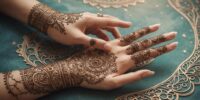Why the Victorian Era Saw a Resurgence in Tarot Interest
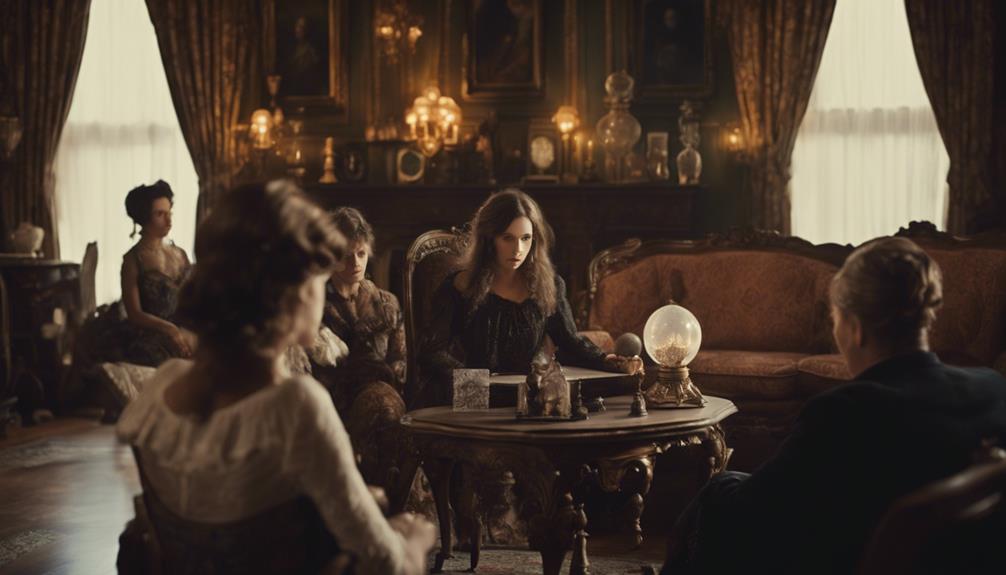
The tarot decks of the time were redesigned with intricate illustrations and symbolism, adding to their allure and mystique. This period also marked the beginning of tarot being used for divination and fortune-telling purposes, further solidifying its place in popular culture.
The Victorian Era's fascination with the occult and spiritualism provided a fertile ground for the tarot to thrive, with many seeking guidance and insight through these mystical cards. The symbolism and imagery of the tarot resonated with the values and beliefs of the time, making it a powerful tool for self-reflection and spiritual exploration.
Cultural Fascination With Mysticism
During the Victorian era, a profound cultural fascination with mysticism captivated the hearts and minds of society's elite. This mystical resurgence had a significant societal influence, shaping art, literature, and even fashion. Tarot symbolism, with its enigmatic imagery and deep-rooted mystique, played a central role in this cultural fascination. The allure of the Tarot cards, each carrying a unique symbolic meaning, sparked curiosity and intrigue among the Victorian populace.
As the Industrial Revolution transformed the landscape of Victorian society, there was a yearning for connection to something beyond the spiritual sphere. The Tarot, with its origins steeped in ancient wisdom and esoteric knowledge, offered a gateway to explore the mysteries of the universe. The intricate symbolism woven into the cards resonated with individuals seeking spiritual enlightenment and a deeper understanding of themselves and the world around them.
In this era of societal change and burgeoning curiosity, the Tarot emerged as a powerful tool for introspection, divination, and self-discovery. Its cultural influence transcended social barriers, uniting individuals in a shared quest for spiritual meaning and personal growth.
Influence of Spiritualism Movement
The Victorian era witnessed a profound intertwining of Tarot with the Spiritualism movement. Believers sought to communicate with the spirit world through various means, including the cards. Tarot decks became a common tool in Spiritualist circles, used to channel messages from the beyond and provide spiritual guidance to practitioners.
This spiritual resonance of Tarot within the context of the Spiritualism movement contributed greatly to its resurgence and popularity during this period.
Spiritualism's Tarot Connection
Evidently intertwined with the rise of the Spiritualism movement in the Victorian era, the Tarot found itself at the center of a profound spiritual awakening. As Spiritualism gained momentum, the Tarot became a tool for seekers to explore the depths of their subconscious and connect with spiritual domains. This connection led to a resurgence of interest in the mystical cards, driving individuals to investigate the profound symbolism and psychological insights they offered. The Tarot's rich history and evolution played an important role in shaping its significance within the Spiritualism movement, drawing enthusiasts closer to the mysteries of the universe.
- Exploration of subconscious domains
- Connection with spiritual dimensions
- Investigating symbolic meanings
- Psychological insights through Tarot
Tarot in Spiritualist Circles
Indisputably intertwined with the burgeoning Spiritualism movement of the Victorian era, the Tarot wielded profound influence within spiritualist circles, serving as a conduit for seekers to explore into the domains of the unknown and commune with higher territories. Within spiritualist circles, Tarot symbolism and psychology intertwined with spiritualist rituals and beliefs, creating a rich tapestry of exploration and connection to the spiritual domain. This fusion of Tarot's intricate symbolism and the spiritualist practices of the time provided individuals with a roadmap to delve into the depths of their psyche and seek guidance from the ethereal territories. The Tarot cards became not just tools for divination but also mirrors reflecting the innermost thoughts and emotions of those who sought solace and wisdom in spiritualist gatherings.
| Tarot Symbolism | Spiritualist Rituals |
|---|---|
| Complex imagery representing subconscious | Seances and mediumship |
| Archetypes reflecting human experiences | Channeling spirits for guidance |
| Psychological exploration through cards | Connecting with departed loved ones |
| Divination to access higher knowledge | Seeking answers beyond the physical territories |
Tarot's Spiritual Resonance
Interwoven with the spiritualist fervor of the Victorian era, the Tarot's spiritual resonance captivated seekers seeking connection with higher domains and deeper truths. The Tarot cards were viewed as more than mere tools for divination; they became gateways to spiritual growth and personal guidance, offering individuals a glimpse into the mysteries of existence. In this era of exploration and curiosity, the Tarot provided a means for individuals to explore into the depths of their own souls and uncover hidden truths about themselves and the world around them.
- Tarot as a mirror reflecting inner truths
- Use of Tarot for introspection and self-discovery
- Seeking spiritual enlightenment through Tarot readings
- Embracing the Tarot as a tool for personal empowerment
Tarot Symbolism and Interpretation
Within the domain of Tarot Symbolism and Interpretation lie the keys to revealing the mysteries of the cards.
Understanding the Tarot Card Meanings, Major Arcana Symbols, and Interpretation Techniques is akin to deciphering a profound language of the soul.
Each card acts as a mirror reflecting the depths of human experience and offering guidance for those who seek wisdom.
Tarot Card Meanings
Tarot card meanings illuminate the depths of symbolism and offer profound insights through interpretation.
- The Fool: Represents new beginnings, innocence, and spontaneity.
- The Lovers: Signifies love, relationships, and choices.
- The Empress: Symbolizes fertility, abundance, and nurturing.
- The Death: Represents endings, transformation, and new beginnings.
Each card in a tarot deck carries its own unique energy and message, reflecting various aspects of life's journey. Understanding the meanings behind these symbols allows individuals to explore their subconscious, gaining clarity and guidance on their path.
The rich history of tarot card designs adds to the allure, with each deck offering a distinct artistic interpretation that enhances the reading experience.
Major Arcana Symbols
How do the Major Arcana symbols in tarot decks reveal profound insights into life's mysteries and guide individuals on their spiritual journey? The symbolic imagery and psychological depth of the Major Arcana cards tap into universal archetypes, offering a mirror to our subconscious minds and shedding light on the various stages of the human experience. Each card represents a key aspect of the spiritual journey, from the innocent wonder of The Fool to the enlightenment of The World. By meditating on these symbols, individuals can gain a deeper understanding of themselves and the world around them, revealing hidden truths and embracing personal growth.
| Major Arcana Symbol | Meaning |
|---|---|
| The Fool | Innocence, new beginnings |
| The Lovers | Choices, partnerships |
| The Tower | Destruction, revelation |
| The Sun | Success, essential |
Interpretation Techniques
Embarking on a journey of tarot interpretation involves unraveling the intricate symbolism embedded within the cards to unfasten profound insights and guidance for spiritual exploration. Tarot symbol interpretation techniques offer a gateway to psychological insights and creative applications, enriching the experience of delving into the mystical realm of the cards.
- Symbolic Imagery: Deciphering the intricate symbols depicted on each card.
- Numerology: Exploring the significance of numbers within the tarot deck.
- Color Symbolism: Understanding the emotional and energetic meanings behind different colors used in the cards.
- Storytelling: Crafting narratives based on the card combinations to unlock deeper meanings and connections.
Role of Women in Tarot Practices
During the Victorian Era, women played a significant role in shaping the cultural and mystical interpretations of tarot practices. Their involvement marked a period of female empowerment, where women found solace, guidance, and a sense of autonomy through the art of tarot reading. Women's roles in tarot resurgence not only challenged societal norms but also provided a platform for them to explore their intuitive abilities and spiritual connection.
In a time when women's voices were often suppressed, tarot practices offered a unique space for self-expression and reflection. Through interpreting the cards, women explored the depths of their psyche, gaining insights into their own lives and those around them. This exploration of the unknown empowered many women to trust their intuition and make decisions with newfound confidence.
The Victorian Era saw women embracing tarot not just as a mystical practice but as a tool for personal growth and empowerment. Their contributions to the tarot resurgence laid the foundation for a more inclusive and diverse community of practitioners, where women's voices weren't just heard but celebrated.
Impact of Industrial Revolution
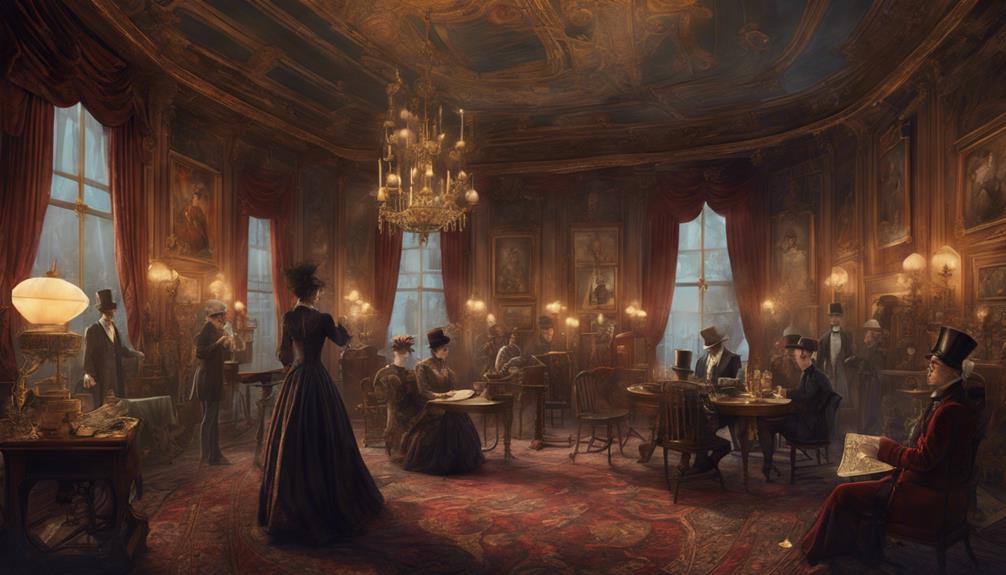
The Industrial Revolution's transformative impact reshaped the societal landscape, influencing the trajectory of tarot practices in unforeseen ways. This period of rapid industrialization brought about significant changes that intertwined with the burgeoning interest in Victorian mysticism, shaping the evolution of tarot readings.
- Urbanization and Accessibility: The shift from agrarian societies thus urban centers due to industrialization made tarot readings more accessible thus a wider audience.
- Symbolism and Innovation: The industrial impact spurred innovation, which influenced the symbolism and artwork found in tarot decks during this era.
- Secularization and Diversification: As society moved towards secular values, tarot practices diversified and adapted thus the changing cultural landscape.
- Consumer Culture and Commercialization: The rise of consumer culture during the Industrial Revolution led thus the commercialization of tarot, making it a marketable commodity for both practitioners and enthusiasts.
Shifting Views on Divination
In the midst of societal transformations, perspectives on divination underwent a notable shift in response to changing cultural currents and intellectual paradigms. As society evolved during the Victorian era, so did the perceptions surrounding divination practices such as tarot reading. What was once viewed with skepticism and fear began to be embraced with a newfound curiosity and openness.
The changing perceptions towards divination can be attributed to the modern applications that emerged during this period. People started to see divination not just as a mystical practice, but also as a tool for introspection, self-discovery, and guidance. Tarot cards, once considered solely for fortune-telling, were now seen as a way to tap into one's subconscious and explore deeper truths about oneself.
This shift in views on divination reflected a broader cultural movement towards individualism and self-exploration. People sought new ways to understand themselves and their place in the world, leading to a reevaluation of ancient practices through a modern lens.
Tarot's Appeal to the Elite
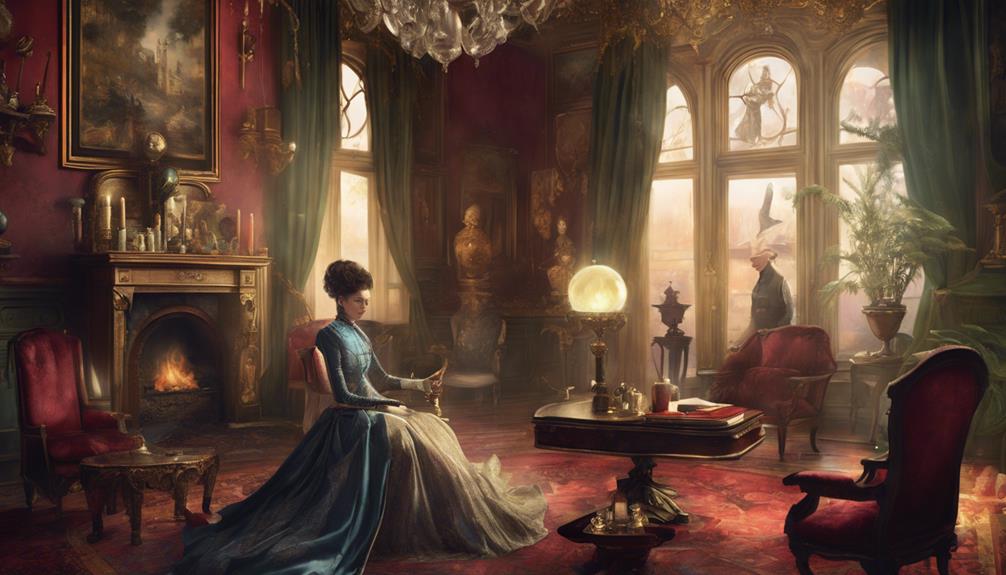
Amidst the opulent salons and grand estates of Victorian high society, the allure of tarot found a compelling fascination among the elite. The mystique and exclusivity of tarot appealed to the aristocratic circles, drawing them into its enigmatic world of symbolism and hidden meanings. Here, in the domain of the elite, tarot transcended mere divination; it became a symbol of status and sophistication, a tool for exploring the depths of the human psyche and uncovering hidden truths.
- Elite Exclusivity: Tarot's mysterious nature appealed to the elite's desire for exclusivity and intrigue.
- Tarot Allure: The allure of tarot lay in its ability to offer insight and guidance, a luxury reserved for the privileged few.
- Aristocratic Intrigue: The aristocracy was drawn to the mysticism and symbolism of tarot, finding in it a reflection of their own complex lives.
- Tarot Symbolism: The rich symbolism of tarot resonated with the elite, offering a language through which to explore their innermost thoughts and desires.
Legacy of Tarot in Victorian Society
With an air of mystery and profound insight, the legacy of tarot in Victorian society captivated minds and hearts alike, leaving an indelible mark on the era's cultural tapestry. Tarot cards not only served as a tool for divination but also became intertwined with the essence of Victorian fashion and aristocratic influence.
| Victorian Fashion | Aristocratic Influence |
|---|---|
| Elaborate dresses | Patronage of tarot readers |
| Rich fabrics | Hosting tarot parties |
| Intricate accessories | Commissioning custom tarot decks |
| Corsets and bustles | Incorporating tarot motifs into decor |
| Formal attire | Using tarot symbolism in literature |
In Victorian society, the allure of tarot extended beyond mere fortune-telling, becoming a symbol of sophistication and intrigue. The elite embraced tarot not only for its mystical appeal but also as a way to showcase their refined tastes and social status. Through the lens of tarot, the Victorian era wove a narrative of elegance, mysticism, and aristocratic charm that continues to fascinate and inspire to this day.
Frequently Asked Questions
How Did the Popularity of Tarot in the Victorian Era Compare to Other Forms of Divination?
In the Victorian era, tarot trumped astrology and palmistry in popularity. The intricate imagery and mystique of tarot cards captivated the era's minds, overshadowing other divination methods with their allure and enigmatic allure.
Were There Any Specific Tarot Decks or Designs That Were Particularly Popular During This Time?
During the Victorian era, various tarot decks and designs gained popularity, reflecting the cultural interests of the time. These Victorian designs continue to influence modern tarot practices, showcasing the enduring impact of that era on divination.
How Did the Portrayal of Tarot in Literature and Art During the Victorian Era Impact Its Cultural Significance?
Literary influence and artistic impact during the Victorian era shaped tarot's cultural significance. Portrayals in literature and art added mystique and symbolism, embedding tarot into the historical context as a powerful tool for introspection and divination.
Did the Resurgence of Interest in Tarot During the Victorian Era Have Any Lasting Effects on Modern Tarot Practices?
The resurgence of interest in tarot during the Victorian era left lasting effects on modern practices. Its intrigue and mystique from that time continue to shape how tarot is perceived and utilized in contemporary spiritual and divinatory contexts.
Were There Any Notable Figures in Victorian Society Who Were Known for Their Involvement in Tarot Practices or Beliefs?
In Victorian society, notable figures embraced tarot practices, adding mystique to their personas. Historical context reveals a fascination with Tarot beliefs among Victorian celebrities, showcasing a blend of tradition and intrigue that captivated the era's imaginations.

